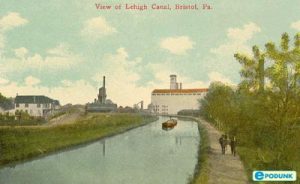Landmark Blog

 The 60-mile Delaware Canal was the built in response to the new nation’s burgeoning commerce and the need to access the anthracite coal deposits in Carbon, Luzerne and Schuylkill counties. The Delaware Canal was necessary to circumvent the unpredictable water levels of the Delaware River caused by seasonal water flows and the unpaved roads inland. By providing a reliable navigation system, the Delaware Canal fueled the fledgling industrial age with anthracite coal and access to the Philadelphia markets.
The 60-mile Delaware Canal was the built in response to the new nation’s burgeoning commerce and the need to access the anthracite coal deposits in Carbon, Luzerne and Schuylkill counties. The Delaware Canal was necessary to circumvent the unpredictable water levels of the Delaware River caused by seasonal water flows and the unpaved roads inland. By providing a reliable navigation system, the Delaware Canal fueled the fledgling industrial age with anthracite coal and access to the Philadelphia markets.
- From 1832 until 1931, the Delaware Canal offered a reliable, navigable route between Easton and Bristol for specially built boats that fit the narrow waterway and locks.
- In 1931, the commercial operation ended and the Commonwealth of Pennsylvania acquired 40 miles of the Canal.
- In 1940, the Commonwealth acquired the full 60 miles of the canal and it became the Theodore Roosevelt State Park.
- In 1978, the canal becomes a National Historic Landmark and, in 1989, the name was changed to Delaware Canal State Park.
Those key dates cannot illustrate the rich and storied history of the Delaware Canal. Many books have been written about this history with plenty of photos and maps to illustrate the life on the canal and the impact the canals had on the communities and industry along the way.
Two favorites are “D&L Trail, Towns and Culture: The Stone Coal Way” and “Delaware and Lehigh Canals.” The first is available on the D&L website store and the second is available on the National Canal Museums website. The gift shop at the National Canal Museum in Hugh Moore Park in Easton carries both of these books, plus a nice selection of books for all ages about the Delaware and Lehigh Canals.








